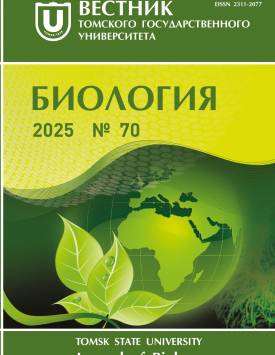Craniological variability of farm and wild sable
The study of animal population structure is a fundamental aspect of ecology, particularly for species of economic importance. This research aims to estimate changes in dimensional characteristics, specifically skull morphology, within the sable population of the Saltykovsky fur farm (Moscow Oblast, Balashikha) from the 1960s to the 2000s. Additionally, we compare caged Sables (Martes zibellina L.) with their wild counterparts using 18 standard skull measurements. Craniometric parameters of both state farm and wild sable populations were analyzed during the period from 1960 to 2000. The state farm population was examined using samples from the early 1960s (n = 49) and early 2000s (n = 512). Skull collections from natural populations were analyzed based on samples from the 1960s (Barguzin) and the 1980s (Demyanka, n = 118; Yugan, n = 130; Vakh, n = 130) (see Table 1). Cranial size tests indicate that the sables of Western Siberia (Yugan, Demyanka) are large, while the smaller forms include the animals from Barguzin and Vakh. State farm animals are classified as medium in size (see Fig. 1). Sables from the captive population show a trend of increasing size from the 1960s to the 2000s: males exhibit significant changes in seven traits withp < 0.05 and five traits at the trend level, while females show significant changes in thirteen traits withp < 0.02. These traits primarily include basilar length, profile length, condylobasal length, facial length of the skull, length of the tooth row, length of the auditory bulla, and measurements of skull width; in females, height traits are also included (see Fig. 4). We believe that the increase in size among modern caged sables is a result of systematic breeding selection conducted during the formation of the main breeding herd at the Saltykovsky farm, as well as the careful pairing of individuals during the breeding season. However, over the past 40 years, a decrease has been observed in certain characteristics, including braincase length, molar row length, braincase width, and the maximum (mastoid) width of the skull. These traits are directly related to the process of chewing food, which is soft on the farm (e.g., porridge, minced meat). The integral indicator, represented by the eigenvalue of the first principal component (which accounts for 81.6% of the explained variance), shows an increase in females from -1.4 to 0.8, which is more significant than the increase observed in males (from -0.8 to 0.9) (see Fig. 3). A comparative study of the dynamics of the size structure of sables revealed that males are significantly larger than females (see Fig. 2). The index of sexual dimorphism (SD) for the measurements studied in adult farm sables during the 2000s varies from 5.8 to 10.6, with an average of 7.9% in favour of males. In the 1960s, the SD index was higher, at 9.8, with a variation ranging from 3.7 to 14.4%. A decrease in sexual dimorphism may indicate the presence of a population mechanism that limits the increase in animal size. Over the past 40 years, the sables at the Saltykovsky farm have experienced an increase in skull size due to directed selection, primarily focusing on females. The captive population of sables exhibits differences in skull size compared to their wild counterparts; however, these differences are intraspecific and do not indicate a directional trend of increase that surpasses that observed in the largest natural groups of the species. Males are significantly larger than females across all studied characteristics (see Table 2), yet there is a noticeable trend towards a decrease in sexual dimorphism within the state farm population. The article contains 4 Figures, 2 Tables, 27References. the authors are grateful to the management and staff of the Saltykovsky tribual farm (Balashikha) for their assistance in collecting biological material and logistics support. The Authors declare no conflict of interest.
Keywords
sable, farm population, craniometrical characters, sex dimorphism, MartesAuthors
| Name | Organization | |
| Shiriaeva Elena L. | Institute of Plant and Animal Ecology of the Ural Branch of the Russian Academy of Sciences | shiriaeva_el@ipae.uran.ru |
| Ranyuk Maryana N. | Institute of Plant and Animal Ecology of the Ural Branch of the Russian Academy of Sciences | ranyuk@ipae.uran.ru |
| Monakhov Vladimir G. | Institute of Plant and Animal Ecology of the Ural Branch of the Russian Academy of Sciences |
References

Craniological variability of farm and wild sable | Vestnik Tomskogo gosudarstvennogo universiteta. Biologiya - Tomsk State University Journal of Biology. 2025. № 70. DOI: 10.17223/19988591/70/6
